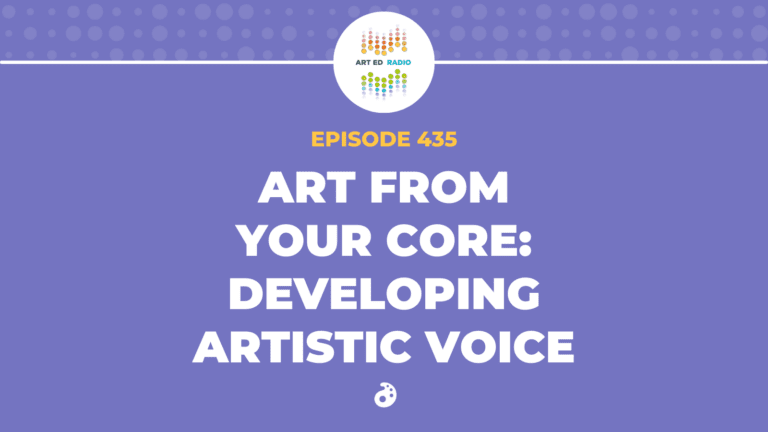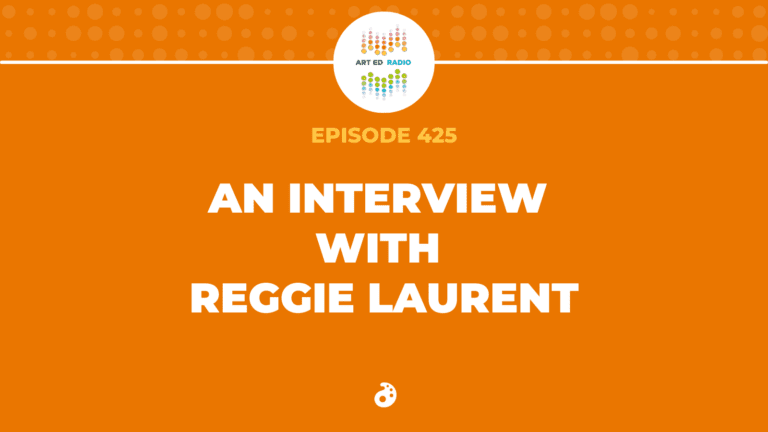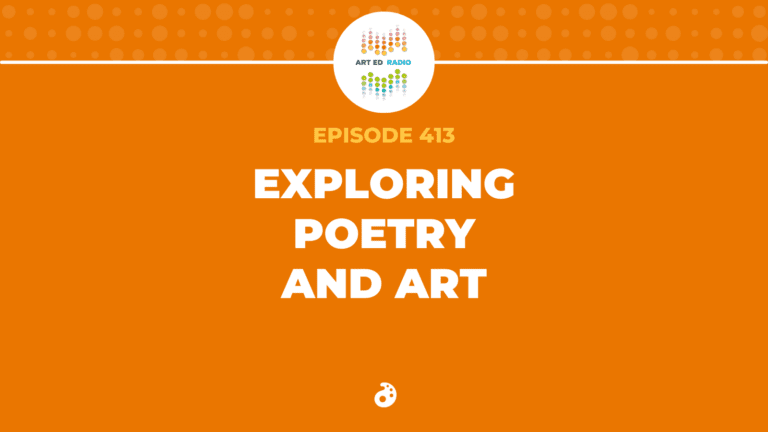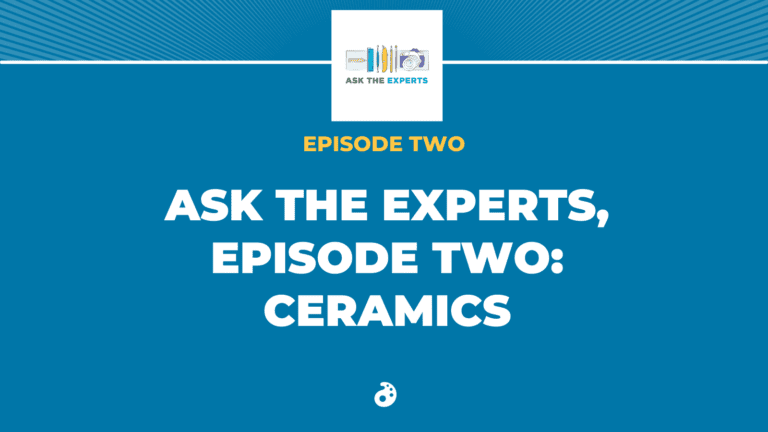Due to popular demand, it is time to revisit the topic of teaching art on a cart. In today’s episode, Tim welcomes back Lindsey Moss to discuss her art on a cart experience and why she recorded an entire PRO Pack about her journey. Listen as they discuss Lindsey’s mindset going into the year, the things she has learned, and some of her favorite lessons and ideas she wants to share. Full Episode Transcript Below.
Resources and Links
- Tips and Tricks for Teaching Art on a Cart
- View Lindsey’s PRO Pack
- What It’s Really Like to Teach on a Cart During a Pandemic
- How to Work Smarter Not Harder with Art on a Cart
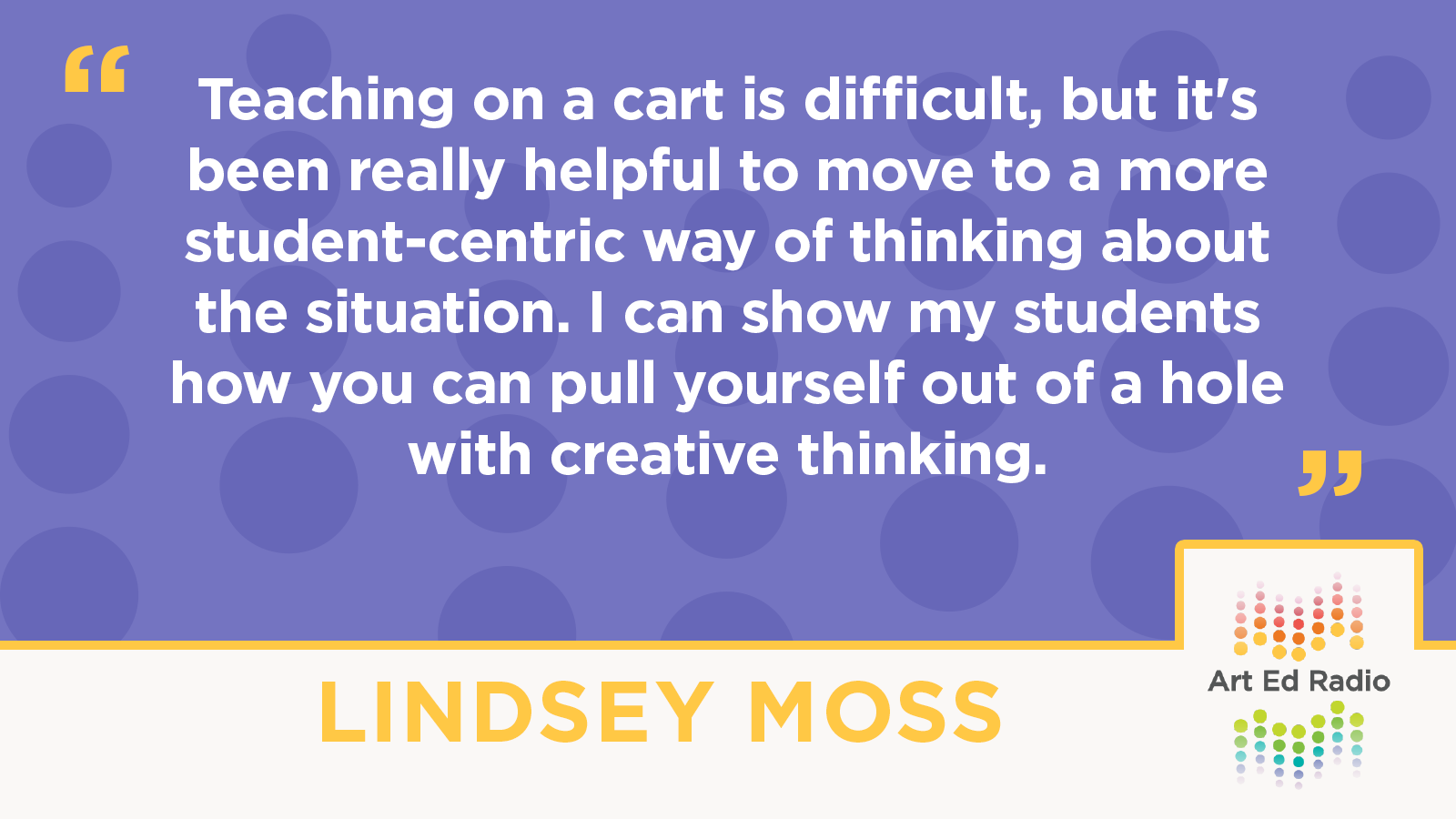
Transcript
Tim: Welcome to Art Ed Radio, the podcast for art teachers. This show is produced by The Art of Education University, and I’m your host, Tim Bogatz.
So many teachers this year, have had to adapt, had to do something differently, had to change their plans and their methodology and the way they approach what they do every day. And for a lot of teachers, that means that they’re shifting to Teaching from a Cart, as art teachers everywhere are losing studios and classrooms and dedicated art-making spaces. Today, I wanted to talk a little bit about Teaching from a Cart with the wonderful Lindsey Moss. If you were listening last week, I discussed just really briefly Lindsey’s pro pack about Teaching Art from a Cart.
Well, since then I have received so many messages about the pack, just loving everything that she put together, all the resources, everything that she shared. I also received a couple requests to have her on the show to talk more about it. And today she is here. We’re lucky enough to have her come join us today. She’s taking a quick break from her online parent-teacher conferences to grace us with her presence. And I wanted to talk to her in just a bit about how she’s managing everything this year, what she’s learned, maybe a few tips and tricks that she has for everyone who is Teaching from a Cart this year.
But before we jump into that conversation, I want to tell you a little bit more about Art Ed Pro. Along with the Teaching Art from a Cart pack, there are also new packs this month on digital drawing and helping students create a body of work, and all three of those are great packs, all worthwhile, especially with the teaching situation that we find ourselves in right now. But in particular, Lindsey’s new pack about Teaching Art on a Cart is amazing. She has so many resources, so many ideas, so many lesson plans for Teaching Art on a Cart that can really make going through that pack worthwhile.
And maybe most importantly, she can maybe change your mindset about teaching from a cart and how you can actually do some amazing things. We’ll talk about all of that here in just a little bit. And after our conversation, make sure you go watch the pack. And if you are not a pro member, you may be able to get your school to actually pay for your subscription. Take a look and get the information you need at theartofeducation.edu/pro. All right. All of that being said, Lindsey is here, so we can go ahead and get the interview started.
Lindsey Moss, welcome back to the show. A couple of questions for you. Number one, how are things right now in the crazy teaching life? And number two, what does your teaching situation look like? How’s the year going for you so far?
Lindsey: Oh man. It’s 2020, Tim. My teaching situation, I would describe it as really fluid. My district offered community choice back in August. People could send their kids back to school full time. They could opt for a hybrid half day model, or they could choose to put their kids fully e-learning. As an art teacher right now, I am teaching full-time in person and balancing with online teaching just a segment of our population. I just have first and second graders online, which has been really interesting, because like the same lesson plans don’t work for those two modalities. It’s just a different fall, I guess.
Tim: Okay. Okay. That sounds about right. And I guess one thing I wanted to talk to you about is I know you’re Teaching on a Cart this year when you’re in person. So can you tell me a little bit about kind of your shift in thinking when you learned that you had to start Teaching on a Cart? What was your initial reaction and has that changed? Has your thinking changed since school has started?
Lindsey: Oh, sure. Yeah. The cart news, I think for anybody it’s a lot to take it first. It’s a lot to swallow, right? But this actually… This is not my first rodeo. I live in a community that have a lot of growth pre-recession. And at one point, we were out of building space. For a period of time, I was on a cart before. When I was told I was transitioning from my big, beautiful art room to a cart this time around, I thought I knew what I was in for. The added pandemic challenge here is no share in supplies in what’s going on in some sections of the country. I teach in northern Illinois and that is definitely a reality here.
You’re pretty much limited to what kids have in their desks or what you’re able to provide to every single student on the art budget. But I feel like for me in my head space anyway, all those first reactions are very teacher centric. It’s like, oh man, I won’t be able to do this. I’m going to have to carry that. It’s like about your personal life position. But for me, it’s been really helpful to move to a more student centric way of thinking about it. And that kind of happened when I actually hit the rooms on the cart.
The first week of school, you realize how much it’s impacting kids. They’ve had to give up so much in a flexible way. As kids, birthday parties look different. They can’t do organized sports. All these things are different. And for a lot of them, losing their safe space, losing the art room is a huge blow for them. You know? And it just meant to me that here I’ve been preaching that art’s a lifelong skill for mental health, for problem solving, for using creativity to address any challenge in your life.
And here it was happening to me and I had a chance to model this for my kids. And I don’t want it to sound like it’s all sunshine and roses over here because it’s not. But I feel like I have a chance to show my kids how you can kind of pull yourself out of a hole with creative thinking. And that’s really what I’ve been trying to do since August.
Tim: Yeah, that’s a really interesting perspective. And that actually brings me to my next question, which is just kind of getting your perspective on what’s working and what’s not. I like hearing you’re thinking. I like making things student centered, but can you just maybe expand on that a little bit more? Can you talk a little bit more about what’s gone really well? Maybe some opportunities that you wouldn’t have had otherwise. And then maybe talk a little bit about what struggles have been? What has gone worse than it?
Lindsey: Sure. Since I work in an elementary school and I have a lot of friends who are teachers, I feel like the relationship component of teaching is so critical and it’s so interesting looking at classroom teachers. They have, depending on the class size in a normal non-pandemic year, between 20 and 30 kids. I feel like there’s an intimacy there with this like smaller group of kids where they really get to know them like on a deep level over one school year. My caseload, I don’t have 30 kids. I’ve got like 550 or 600.
I do know them across multiple years, but you see them at a four day rotation and you’re just juggling these classes. Painting with 30 kids is daunting. So like a weird side effect of the pandemic and being on the cart is class sizes have to be a lot smaller in order for kids to be six feet apart. As I mentioned, in my district we’ve got half the kids or whatever are doing hybrid or online. My class sizes right now are like 15, which is not something I’ve ever experienced ever in my professional career.
And it’s just really interesting, when you have that amount of kids, supply pass out, demo, problem solving or conferencing about brainstorming stuff, everything takes less time, so you have more time with each kid. And so sort of like an unexpected benefit of this is I feel like the kids who are there at school, I’m getting to know kids better on a more deep level than I ever have before. It’s kind of like we’re all going through this really weird thing together, but there’s a camaraderie there that has been really nice.
I feel like a lot of their idea development and thinking in their art this year is a little stronger than usual, because they have a little more of my attention, a little more time for me to talk to them one-on-one. The flip side though, the actual visual execution on some of the art is maybe not as good as in the past. Because like I mentioned, we’re doing no shared supplies. One solution is to add art supplies to the district fall supply list, which is what we did. We added like watercolors and oil pastels. My community’s awesome.
They were super generously purchased those things for their kids. But I mean, as art teachers, we all know the sliding scale of what [inaudible 00:10:25] And I seem to have a lot of dollars to watercolors with the bristles on the brush are made out of old toothbrushes. It’s brutal. My kids have a lot of great ideas, but like watercolor in particular, we are struggling this year just because they’re used to high quality brushes and beautiful watercolors and that is not what we’ve got.
Tim: Yeah, it’s a step down for sure. And I’ve heard that from a lot of teachers where just quality is limited because suppliers are so limited. But again, it’s not a normal year and you can’t beat yourself up for that at all.
Lindsey: Right. Right.
Tim: Now, the other thing that you’ve done since you are an overachiever, I suppose, is as soon as you learned that you were Teaching Art on a Cart and you kind of wrapped your head around that, you said, “Hey, I should record an entire pro pack.” And then you did that, which I’m super impressed with. It came out a couple of weeks ago and people have loved it and just like rave reviews so far. I want to talk to you about that. So first of all, what made you want to dive right in and record that back. And secondly, how did you put all that together so quickly?
Lindsey: Sure. It’s funny. When I found out I was going back to the car, there’s a lot of online forums for art teachers on a cart. I thought, oh man, I’m going to get some really seasoned advice from seasoned cart users. What I found is a lot of people have a cart situation and they’re kind of like stuck there. They’ve been on a cart most of their career, or the reverse is true. And a lot of people have had a big, beautiful art room or dedicated to art-making space most of their career.
And I think what’s most helpful is hearing from somebody who’s had both, because they understand the differences between the classroom and the cart and how you might make a transition there and back. It’s having had a little bit of that perspective. I felt like that was something I wanted to share. But also when The Art of Education University makes a pro pack, they have graphic designers that produce resources and beautiful things. So I had sort of like a selfish interest.
I can make this pack. I could totally get them to make what I need.
Tim: Exactly.
Lindsey: And if I need it, probably other people do too. Amanda Heyn heads up Pro. I pitched her the idea about the pack. She’s like, “Yes, let’s kamikaze this.” So we got it done pretty quick.
Tim: Record time for turnaround. I mean, school starts in September and then we have a pack out in November, which I think is pretty impressive. Let’s chat about those beautiful, beautiful resources, the graphic design put together. Can you talk about a couple of your favorite resources that are in the pack?
Lindsey: Sure. There are so many good things in there. It would be hard to pick one. There are some student-facing activities. There are suggestions for how you can toggle different types of media into something that would be more manageable on the cart. There’s different organizational charts to help you think through or stage the materials you’re going to need for each class for the week, so you don’t get into a classroom and discover you’ve forgotten something critical. Full disclosure, that still happens to me almost once a week.
Tim: You know what? That still happens to everybody no matter how long you’ve been doing it.
Lindsey: Yeah. There’s a lot of good stuff in there. And then at the end of the pack, I was able to share kind of some lessons that are working for me right now on the cart. It’s kind of interesting. I feel like kids now, I don’t know if it’s because of all the technology they have access to or whatever, but they just seem really sophisticated to me. They’re interested in deeper techniques and deeper thinking with art. And so I felt at first like just using crayons and markers and those types of things off the cart was going to be really limiting this year.
But it’s turns out, a lot of really foundational stuff that was part of even art curriculums when I was a kid, they are really enamored with because they just kind of skipped over that. It’s weird. Folded paper that pops out and makes a 3D part, like those kinds of things my kids have really been into. So at the end of the pack, I share a couple of those lessons and how I introduced it to my classes. I picked the ones they’d been liking the best. Man, they liked those pop-out cards. I don’t know.
Tim: That’s a big deal. I remember loving those when I was a kid. And yeah, it’s interesting to think about how kids have not done that or skipped over that like you said. So that’s kind of cool. Yeah, I think there’s a lot there for people to dive into and kind of explore between resources and lessons. A lot of helpful stuff. And then I guess just finally, like I said, the reaction to the pack has been overwhelmingly positive, and I guess I would just Mark that up to people really needing support and information right now.
I guess to close things out, can you maybe share some words of advice or words of encouragement for people who need support, people who find themselves Teaching on a Cart right now and are maybe struggling with it?
Lindsey: Sure. I mean, I think the biggest thing is to give yourself a little bit of personal grace, because it’s okay and natural to struggle with this. At any one time, you’re not just facing a curriculum or instructional strategy challenge. You’re also facing challenges in your personal life like we’re living and doing. It’s unprecedented times. And it’s okay to not have everything figured out. It’s okay to not have it be the absolute best year of our instruction you’ve ever given.
I think also there’s room to still find joy in what we do professionally and model that for kids. But also, I guess, current fatigue is real. Anything sounds manageable at first, but we’re not talking about like a short-term thing right now. We’re talking about like a longer term change to the way we deliver our instruction. I guess pace yourself, because it’s a marathon, not a sprint, right?
Tim: Yes, for sure.
Lindsey: But I think we can do this. If there’s any segment of the education population that’s like well-positioned to come up with creative solutions and make it through, it’s art teachers. We will come out the other end. We will.
Tim: For sure. Well, Lindsey, thank you just for being so willing to share everything through Pro Packs and resources and coming on to talk about all of this. We appreciate your time. We appreciate everything that you’re doing to kind of help people along. Thank you.
Lindsey: Yeah, thanks for having me, Tim.
Tim: All right. We’ll talk to you again soon. All right. That was a wonderful conversation with Lindsey. I love talking to her, and I really appreciated what she said about changing your mindset, shifting your mindset, between what you have to do as a teacher and what you have the opportunity to do for your students. I would say that thinking in that way and shifting your mindset in that way can have some incredible benefits for both you and your students. All right.
And just in the spirit of making this podcast as helpful as possible, we’ll link to a lot of other resources in the show notes, so you can check it out and maybe continue the learning. We have a previous episode we did with Kit Lang about teaching on a cart that was also excellent. You can check out all the resources. Make sure you check out Lindsey’s pack. And hopefully if you are Teaching on a Cart, you can find some of the support you need for your current situation.
Art Ed Radio is produced by The Art of Education University with audio engineering from Michael Crocker. Thank you as always for listening. We will talk to you next week.
Magazine articles and podcasts are opinions of professional education contributors and do not necessarily represent the position of the Art of Education University (AOEU) or its academic offerings. Contributors use terms in the way they are most often talked about in the scope of their educational experiences.
